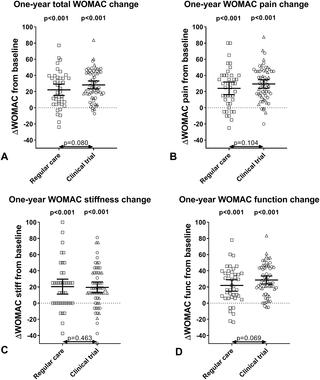Our official English website, www.x-mol.net, welcomes your
feedback! (Note: you will need to create a separate account there.)
Knee joint distraction in regular care for treatment of knee osteoarthritis: A comparison with clinical trial data.
PLOS ONE ( IF 2.9 ) Pub Date : 2020-01-22 , DOI: 10.1371/journal.pone.0227975 Mylène P Jansen 1 , Simon C Mastbergen 1 , Ronald J van Heerwaarden 2 , Sander Spruijt 3 , Michelle D van Empelen 4 , Esmee C Kester 4 , Floris P J G Lafeber 1 , Roel J H Custers 4
PLOS ONE ( IF 2.9 ) Pub Date : 2020-01-22 , DOI: 10.1371/journal.pone.0227975 Mylène P Jansen 1 , Simon C Mastbergen 1 , Ronald J van Heerwaarden 2 , Sander Spruijt 3 , Michelle D van Empelen 4 , Esmee C Kester 4 , Floris P J G Lafeber 1 , Roel J H Custers 4
Affiliation

|
OBJECTIVES
Knee joint distraction (KJD) has been evaluated as a joint-preserving treatment to postpone total knee arthroplasty in knee osteoarthritis patients in three clinical trials. Since 2014 the treatment is used in regular care in some hospitals, which might lead to a deviation from the original indication and decreased treatment outcome. In this study, baseline characteristics, complications and clinical benefit are compared between patients treated in regular care and in clinical trials.
METHODS
In our hospital, 84 patients were treated in regular care for 6 weeks with KJD. Surgical details, complications, and range of motion were assessed from patient hospital charts. Patient-reported outcome measures were evaluated in regular care before and one year after treatment. Trial patients (n = 62) were treated and followed as described in literature.
RESULTS
Patient characteristics were not significantly different between groups, except for distraction duration (regular care 45.3±4.3; clinical trials 48.1±8.1 days; p = 0.019). Pin tract infections were the most occurring complication (70% regular care; 66% clinical trials), but there was no significant difference in treatment complications between groups (p>0.1). The range of motion was recovered within a year after treatment for both groups. WOMAC questionnaires showed statistically and clinically significant improvement for both groups (both p<0.001 and >15 points in all subscales) and no significant differences between groups (all differences p>0.05). After one year, 70% of patients were responders (regular care 61%, trial 75%; p = 0.120). Neither regular care compared to clinical trial, nor any other characteristic could predict clinical response.
CONCLUSIONS
KJD as joint-preserving treatment in clinical practice, to postpone arthroplasty for end-stage knee osteoarthritis patient below the age of 65, results in an outcome similar to that thus far demonstrated in clinical trials. Longer follow-up in regular care is needed to test whether also long-term results remain beneficial and comparable to trial data.
中文翻译:

常规治疗膝关节骨性关节炎的膝关节牵张:与临床试验数据的比较。
目的在三项临床试验中,膝关节牵引术(KJD)已被评估为保留关节疗法,以推迟膝关节骨关节炎患者的全膝关节置换术。自2014年以来,该疗法已在一些医院的常规护理中使用,这可能会导致偏离原始适应症并降低治疗效果。在这项研究中,比较了常规护理和临床试验中患者的基线特征,并发症和临床获益。方法在我院,对84例KJD患者进行了为期6周的常规护理。手术细节,并发症和活动范围从患者医院病历表中进行评估。在治疗前和治疗后的常规护理中评估患者报告的结局指标。试验患者(n = 62)按文献所述接受治疗和随访。结果除分心持续时间外,两组患者的特征无显着差异(常规护理45.3±4.3;临床试验48.1±8.1天; p = 0.019)。针道感染是最常见的并发症(70%的常规护理; 66%的临床试验),但两组之间的治疗并发症无显着差异(p> 0.1)。两组治疗后一年内,运动范围都恢复了。WOMAC问卷显示,两组在统计学和临床上均有显着改善(所有子量表的p <0.001和> 15分),两组之间无显着差异(所有差异p> 0.05)。一年后,有70%的患者有反应(常规护理为61%,试验为75%; p = 0.120)。常规护理与临床试验相比,任何其他特征都不能预测临床反应。结论KJD作为临床实践中的保留关节疗法,推迟了65岁以下终末期膝骨关节炎患者的关节置换术,其结果与迄今为止在临床试验中证明的结果相似。需要对常规护理进行更长时间的随访,以测试长期结果是否仍然有益并与试验数据相当。
更新日期:2020-01-23
中文翻译:

常规治疗膝关节骨性关节炎的膝关节牵张:与临床试验数据的比较。
目的在三项临床试验中,膝关节牵引术(KJD)已被评估为保留关节疗法,以推迟膝关节骨关节炎患者的全膝关节置换术。自2014年以来,该疗法已在一些医院的常规护理中使用,这可能会导致偏离原始适应症并降低治疗效果。在这项研究中,比较了常规护理和临床试验中患者的基线特征,并发症和临床获益。方法在我院,对84例KJD患者进行了为期6周的常规护理。手术细节,并发症和活动范围从患者医院病历表中进行评估。在治疗前和治疗后的常规护理中评估患者报告的结局指标。试验患者(n = 62)按文献所述接受治疗和随访。结果除分心持续时间外,两组患者的特征无显着差异(常规护理45.3±4.3;临床试验48.1±8.1天; p = 0.019)。针道感染是最常见的并发症(70%的常规护理; 66%的临床试验),但两组之间的治疗并发症无显着差异(p> 0.1)。两组治疗后一年内,运动范围都恢复了。WOMAC问卷显示,两组在统计学和临床上均有显着改善(所有子量表的p <0.001和> 15分),两组之间无显着差异(所有差异p> 0.05)。一年后,有70%的患者有反应(常规护理为61%,试验为75%; p = 0.120)。常规护理与临床试验相比,任何其他特征都不能预测临床反应。结论KJD作为临床实践中的保留关节疗法,推迟了65岁以下终末期膝骨关节炎患者的关节置换术,其结果与迄今为止在临床试验中证明的结果相似。需要对常规护理进行更长时间的随访,以测试长期结果是否仍然有益并与试验数据相当。











































 京公网安备 11010802027423号
京公网安备 11010802027423号